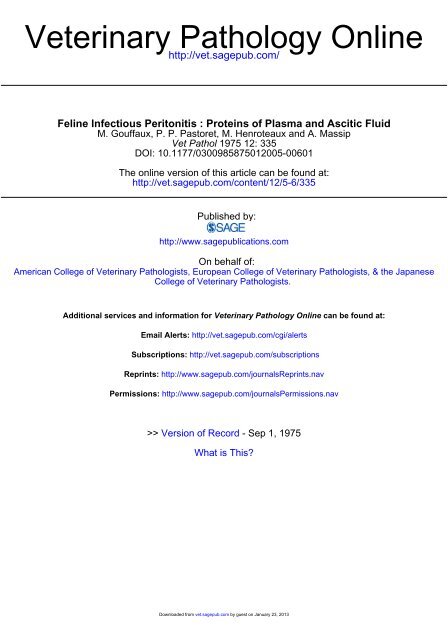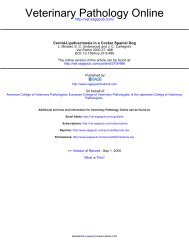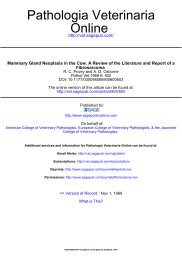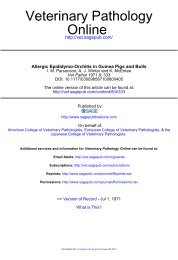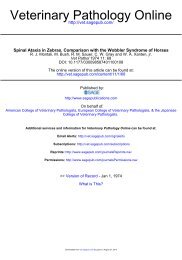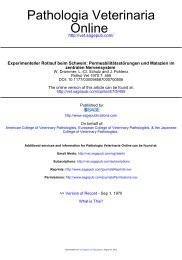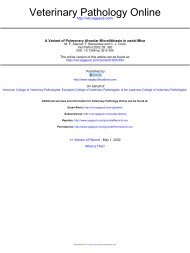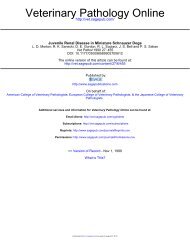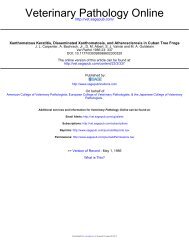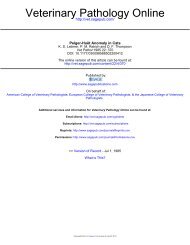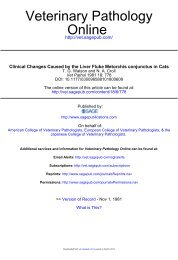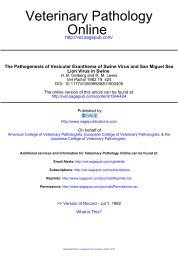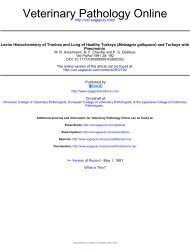Feline Infectious Peritonitis - Veterinary Pathology
Feline Infectious Peritonitis - Veterinary Pathology
Feline Infectious Peritonitis - Veterinary Pathology
Create successful ePaper yourself
Turn your PDF publications into a flip-book with our unique Google optimized e-Paper software.
<strong>Veterinary</strong> <strong>Pathology</strong> Online<br />
http://vet.sagepub.com/<br />
<strong>Feline</strong> <strong>Infectious</strong> <strong>Peritonitis</strong> : Proteins of Plasma and Ascitic Fluid<br />
M. Gouffaux, P. P. Pastoret, M. Henroteaux and A. Massip<br />
Vet Pathol 1975 12: 335<br />
DOI: 10.1177/0300985875012005-00601<br />
The online version of this article can be found at:<br />
http://vet.sagepub.com/content/12/5-6/335<br />
Published by:<br />
http://www.sagepublications.com<br />
On behalf of:<br />
American College of <strong>Veterinary</strong> Pathologists, European College of <strong>Veterinary</strong> Pathologists, & the Japanese<br />
College of <strong>Veterinary</strong> Pathologists.<br />
Additional services and information for <strong>Veterinary</strong> <strong>Pathology</strong> Online can be found at:<br />
Email Alerts: http://vet.sagepub.com/cgi/alerts<br />
Subscriptions: http://vet.sagepub.com/subscriptions<br />
Reprints: http://www.sagepub.com/journalsReprints.nav<br />
Permissions: http://www.sagepub.com/journalsPermissions.nav<br />
>> Version of Record - Sep 1, 1975<br />
What is This?<br />
Downloaded from<br />
vet.sagepub.com by guest on January 23, 2013
Vet. Pathol. 12: 335-348 (1975)<br />
<strong>Feline</strong> <strong>Infectious</strong> <strong>Peritonitis</strong><br />
Proteins of Plasma and Ascitic Fluid<br />
M. GOUFFAUX, P. P. PASTORET, M. HENROTEAUX and A. MASSIP<br />
Faculty of <strong>Veterinary</strong> Medicine, University of Liege, Brussels<br />
Absrrucr. Electrophoreses of sera, plasma and ascitic fluids of cats with natural or<br />
experimental infectious peritonitis show important modifications. Special stainings of<br />
electrophoreses and chromatographic and immunoelectrophoretic technics characterized<br />
some of the modified proteins. In the experimental disease, fibrinogen, haptoglobin,<br />
transferrin, and probably orosomucoid are increased; in the natural disease, in addition<br />
to these modifications, the y-globulins are strongly increased; the immunoglobulins found<br />
in the often abundant ascitic fluid belong to the IgG class. Increased proteins such as<br />
fibrinogen, haptoglobin and orosomucoid and decreased albumin are aspecific aspects of<br />
inflammatory processes, whereas hyperganimaglobulinemia appears in the course of<br />
immunological response. The rapid evolution of the experimental disease explains the fact<br />
that immunoglobulins do not increase.<br />
In a previous paper [ 151, we described the first experimental transmissions<br />
of feline infectious peritonitis from clinically affected animals. The clinical,<br />
hematological and anatomopathological aspects and the wide geographical<br />
spread of the natural disease were stressed ; since then, infectious peritonitis<br />
has been also reported in Australia [I 1,281, Switzerland [20] and Germany<br />
1211.<br />
In the present paper, some of the clinical and anatomopathological aspects<br />
of the experimental as well as the natural cases are described and compared<br />
with those previously reported.<br />
Materials and Methods<br />
The animals affected by natural disease (NOC) varied in age and sex. They were<br />
numbered from NOC 01 to 09. At the last stage of the disease, serum, plasma, pleural and<br />
ascitic fluids were collected. After death, samples were taken for histopathological exami-<br />
Downloaded from<br />
vet.sagepub.com by guest on January 23, 2013
336 GOUFFAUX er al.<br />
Table I. Inoculations and results<br />
Cat Age Sex Origin of Nature and quantity Date of<br />
years inoculums of inoculum' inoculation<br />
Exp. 10 5 F Noc 05 liver suspension in<br />
5 ml PBS<br />
8/5/74<br />
Exp. 11 3 M exp. 09 organs suspension<br />
in 10 ml PBS<br />
8/5/74<br />
Exp. 12 8 F exp. 08 liver suspension<br />
in 10 ml PBS<br />
8/5/74<br />
Exp. 13 1 F Noc 04 liver suspension<br />
in 10 ml PBS<br />
8/5/74<br />
l PBS = phosphate-buffered saline.<br />
FIP = feline infectious peritonitis.<br />
Resul tsa<br />
dead of FIP<br />
on 29/5/14<br />
killed with<br />
FIP on 29/5/74<br />
recovered from<br />
the disease<br />
no sign of disease<br />
nations. Liver, spleen, ascitic fluid and urine samples were aseptically taken and stored at<br />
-20°C to obtain a stock of inoculation material. Soon after abdominal puncture, 5 ml of<br />
ascitic fluid from cats NOC 06 and 09 were stored in five heparinized (25 mg heparinlml)<br />
and five nonheparinized tubes, by pairs, respectively, at -20, 4, 20, 37, and 56°C for 16 h.<br />
All were then brought to 20°C, examined, and submitted to agarose gel electrophoresis.<br />
Four conventional cats (numbered exp. 10 to exp. 13) of various ages and sex and not<br />
previously treated were inoculated with infected organ suspensions in phosphate-buffered<br />
saline (PBS) (table I). Kanacilline@ was added to the virulent material in order to give 5 mg<br />
of kanamycin sulfate to each cat. Temperature was recorded each day, in the morning, from<br />
2 days before the inoculation to the end of the disease. Two days before and every day<br />
after inoculation, blood samples were collected through the ear vein from fasting, tran-<br />
quillized (Rompunm) cats for a blood count; simultaneously, blood was taken by cardiac<br />
puncture to obtain serum and plasma. Soon after death, the same samples were taken as<br />
in natural cases.<br />
Total proteins of sera, plasma, pleural and ascitic fluids were assayed by the biuret<br />
method; serum glutamic-oxalacetic and glutamic-pyruvic (SCOT, SGPT) were measured<br />
by the Sigma Chemical method [19].<br />
Electrophoreses were performed on agarose plates in barbital buffer, pH 8.6, ionic<br />
strength 0.075, stained by amido-black for total proteins and by periodic acid-Schiff (PAS)<br />
for glycoproteins 1221. Fibrinogen was identified by comparison of serum and plasma<br />
electrophoreses. Haptoglobin was determined by hydrogen-peroxide and benzidine 191<br />
after human hemoglobin was added. To determine the saturation capacity of the hapto-<br />
globin in hemoglobin, serum or ascitic fluid electrophoreses were performed with increas-<br />
ing amounts of hemoglobin (from 1 to 20 mglml).<br />
Immunoelectrophoreses were carried out in agarose gel (Immunoagaroslide, Millipore)<br />
in barbital buffer, pH 8.6, ionic strength, 0. I. Goat serum against normal cat whole serum<br />
was supplied by Nordic Diagnostic (Tilburg, The Netherlands), and Dr. J.P. VAERMAN<br />
[23,24] provided the rabbit sera against cat IgG, and IgG2, IgA and IgM, as well as rabbit<br />
serum against dog transferrine.<br />
Downloaded from<br />
vet.sagepub.com by guest on January 23, 2013
<strong>Feline</strong> <strong>Infectious</strong> <strong>Peritonitis</strong> 337<br />
Ten milliliters of ascitic fluid were clarified and then dialyzed against 2% NaCl (w/v)<br />
buffered with 0.02 M Tris-HCI buffer, pH 8.0, containing 0.1 YO NaN,, and then eluted with<br />
the same buffer on a column (Pharmacia, Uppsala, Sweden; K 26/100) of Sephadex (3-200<br />
under a 40-cm water pressure. The eluate was divided into five fractions that were con-<br />
centrated prior to electrophoretic and immunoelectrophoretic analysis in agarose gel.<br />
Twenty milliliters of ascitic fluid were dialyzed against 0.005 M Tris-HCI buffer, pH 8.0,<br />
and then layered over a column (Pharmacia; K 26/30) of diethylaminoethyl Sephadex A-50<br />
balanced by the same buffer. The proteins eluted in this step form a first fraction. Asecond<br />
fraction results from the elution by a 0.04 M Tris-HCI buffer, pH 8.0; and a third one from<br />
the elution by a 0.04 M Tris-HCI buffer, pH 8.0, containing 1 M NaCI. The three fractions<br />
were concentrated before electrophoretic and immunoelectrophoretic analysis in agarose<br />
gel.<br />
The eluates were concentrated through ultrafiltration Millipore cells, with Pellicon<br />
PSAC membranes, under a pressure of 4 kg/cm2.<br />
Antiserum against cat IgG was prepared by intradermic inoculations of the rabbit<br />
with the second fraction obtained by ion exchange chromatography, emulsified in the<br />
complete Freund’s adjuvant. The y-globulins thus obtained were purified by 40% ammo-<br />
nium sulfate precipitation, then absorbed on the first elution fraction on Sephadex G-200<br />
of the ascitic fluid.<br />
Results<br />
Experimental Disease<br />
Two of the four inoculated cats (exp. 10 and 11) had a typical experimen-<br />
tal disease (table I). The clinical evolution, hematological findings, body<br />
temperature, macroscopic and microscopic lesions corresponded to those<br />
previously described [6,12,14,25]. The duration of the experimental disease<br />
ranged from 2 to 3 weeks. The most important clinical findings were anorexia,<br />
weakness, and wasting; the first sign was a rise in body temperature on the<br />
second day; after a short remission, there was hyperthermia and, before<br />
death, strong hypothermia. The leukocyte count was usually elevated shortly<br />
after the onset of the fever. There was marked neutrophilia up to 90%. The<br />
red blood cell count showed no significant modification. Each infected cat<br />
had less than 100 ml of fluid in the peritoneal cavity and had diffuse fibrinous<br />
peritonitis. Discrete, white foci were obvious all over the liver and kidneys.<br />
Many foci of necrosis and neutrophilic infiltration of fibrinous exudate were<br />
found on the serosae, and within the parenchyma of the liver and kidneys.<br />
Germinative follicles of the spleen and abdominal lymph nodes were hyper-<br />
trophied by accumulation of cellular debris, histiocytes, and neutrophils [ 151.<br />
One cat (exp. 12) showed clinical, hematological and electrophoretic<br />
signs of an experimental disease until the 10th day, then everything returned<br />
Downloaded from<br />
vet.sagepub.com by guest on January 23, 2013
338 GOUFFAUX er al.<br />
Origin<br />
Table It. Agarose gel electrophoreses;<br />
values for normal plasma and plasma and ascitic fluid 20 days after inoculation<br />
Plasma exp. 10<br />
before inoculation<br />
Plasma exp. I0<br />
20 days<br />
after inoculation<br />
Ascitic fluid exp. 10<br />
20 days<br />
after inoculation<br />
Units A1 buniin a, u, P? y Total<br />
protein<br />
45.00<br />
3.06<br />
29.23<br />
3.10<br />
35.19<br />
2.01<br />
~<br />
8.50 10.00 13.50 8.00 1.50 100<br />
0.58 0.68 0.92 0.55 1.02 6.88<br />
12.31 18.46 13.85 18.46 7.69 100<br />
1.30 1.96 1.47 1.96 0.82 10.60<br />
9.26 20.37 11.11 7.41 16.67 100<br />
0.53 1.16 0.63 0.42 0.95 5.70<br />
to normal. Clinical and hematological recovery coincided with an increase<br />
of the serum y-globulins, but a decrease of hyperalpha-2 globulinemia<br />
occurred. One cat (exp. 13) showed no signs of the disease.<br />
Total protein values of plasma and sera of cats (exp. 10, 11) showed no<br />
modifications that could be significantly related to the disease since there are<br />
important variations of these values in sera of cats without disease [4,5, 141.<br />
The ascitic fluid contained fewer proteins than plasma and serum. The al-<br />
bumin/globulin ratio was decreased in relation to hypergammaglobul-<br />
inemia.<br />
Serum transaminases determinations showed no significant variations in<br />
the course of the experimental disease, except for a high increase of the<br />
SGOT at the last stage of the disease in one cat (exp. 10) [ 1,201. Electrophoreses<br />
of serum and plasma of animals with typical experimental disease showed<br />
important modifications in albumin and a- and P-globulins (table 11; fig. 1,2).<br />
Fibrinogen increased as early as the 8th day after inoculation (fig. 1).<br />
From the 4th day, a net and progressive increase of a narrow band of an<br />
a,-protein occurred (fig. 2). This protein has a slightly lighter molecular<br />
weight than the 7s immunoglobulins, as its presence in the 4th fraction of<br />
elution on Sephadex (3-200 suggests (fig. 3). Its glycoprotein nature appears<br />
after using PAS to analyze the electrophoreses of the same sera. We showed<br />
by electrophoresis of the serum after addition of hemoglobin that this a,-<br />
band corresponded to the haptoglobin. The increase of haptoglobulinemia<br />
was demonstrated by electrophoresis of serum sampled at different stages of<br />
the disease, after addition of hemoglobin in an amount slightly above that<br />
needed for the saturation of haptoglobin of the richest serum, taken before<br />
Downloaded from<br />
vet.sagepub.com by guest on January 23, 2013
1<br />
<strong>Feline</strong> <strong>Infectious</strong> <strong>Peritonitis</strong> 339<br />
2 3 4 5 6<br />
Fig. 1. Agarose gel electrophoresis. Cat exp. 10. Anode upwards. I = Plasma before<br />
inoculation; 2-6 = plasma from 4th to 20th day after inoculation.<br />
1 2 3 4 5 . 6 7<br />
Fig. 2. Agarose gel electrophoresis. Cat exp. 10. Anode upwards. 1 = Serum before<br />
inoculation; 2-6 = sera from 4th to 20th day after inoculation; 7 = ascitic fluid at the<br />
20th day.<br />
Downloaded from<br />
vet.sagepub.com by guest on January 23, 2013
340 GOUFFAUX ei at.<br />
A F 1 2 3 4 5<br />
Fig. 3. Agarose gel electrophoresis. Eluted fractions one through five on Sephadex<br />
G-200 of ascitic fluid compared to whole ascitic fluid (AF). Anode upwards.<br />
death. The decrease of the free hemoglobin band and the progressive develop-<br />
ment of the haptoglobin-hemoglobin complex band proved the evolutive<br />
character of the increasing serum value in haptoglobin (fig. 4). At the last stage<br />
of the disease, the saturation capacity of the serum in hemoglobin amounts<br />
to 10 mg/ml, whereas the control serum is already saturated by 1.5 mg/ml.<br />
Electrophoreses of sera taken during the disease and stained by PAS or<br />
by amido-black (fig. 2) showed a steady increase of an a,-glycoprotein.<br />
A steady increase of a band with P,-mobility can be followed until the<br />
20th day in serum and plasma (fig. 1,2); it was also found in the fifth eluted<br />
fraction of the ascitic fluid on Sephadex G-200; its molecular weight is there-<br />
fore close to that of albumin. The rabbit serum against dog transferrine [23]<br />
showed in the serum of affected cats and in the fifth eluted fraction of the<br />
ascitic fluid on Sephadex G-200 a protein arc resulting from a cross-reaction<br />
between cat and dog transferrine.<br />
The y-globulins’ electrophoretic pattern showed no change in the course<br />
of the experimental disease (fig. 2). The proteins of the ascitic fluid were<br />
similar in quantity to those of the serum (table 11; fig. 2); the ascitic fluid did<br />
Downloaded from<br />
vet.sagepub.com by guest on January 23, 2013
<strong>Feline</strong> <strong>Infectious</strong> <strong>Peritonitis</strong> 341<br />
1 2 3 4 5 6 7 8<br />
Fig. 4. Agarose gel electrophoresis. Cat exp. 10. Anode upwards. 1 = Pure human<br />
hemoglobin (7.5 mglml); 2-7 = serum before inoculation and sera from 4th to 20th day<br />
added with 10 mg/mI of pure hemoglobin and stained for hemoglobin; 8 = serum at the<br />
20th day added with 10 mg/ml of pure hemoglobin and stained with amido-black.<br />
not contain increased fibrinogen. Comparison between immunoelectropho-<br />
resis of serum and plasma taken at the beginning and at the end of the dis-<br />
ease gave no further information.<br />
Natural Disease<br />
Clinical, hematological and anatomopathological aspects of the natural<br />
disease have been reported [12, 15, 17,25,29, 301. Its evolution ranges from<br />
a few weeks to several months. The main clinical findings are anorexia,<br />
weakness, often hyperthermia, and progressive abdominal distension. Other<br />
symptoms such as diarrhea and icterus exudative uveitis may be seen. Hema-<br />
tological examination shows a mild anemia and leukocytosis, with neutro-<br />
philia, lymphopenia and eosinopenia. The abdominal cavity is filled by an<br />
abundant and characteristic ascitic fluid containing fibrin tags; layers or<br />
small plaques of fibrinous material can be seen on the serosae, mainly at the<br />
surface of parenchyma. Pleural exudate is less frequently encountered. Prin-<br />
cipal microscopic lesions are fibrinous peritonitis. Fibrinous deposits are<br />
seen on the serosae of abdominal organs and contain many plasma cells,<br />
lymphocytes, histiocytes, neutrophils and cellular debris. Inflammatory reac-<br />
tion frequently involves underlying parenchyma of the liver and kidneys.<br />
Similar lesions may be seen on the thoracic serosae, meninges and in the<br />
Downloaded from<br />
vet.sagepub.com by guest on January 23, 2013
342 GOUFFAUX ei al.<br />
Table III. Agarose gel electrophoreses; values for normal plasma and plasma and ascitic<br />
fluid taken from cat with a natural case, at end of evolution<br />
Origin Units Albumin a, a? p, p2 y Total<br />
protein<br />
~~<br />
Plasma exp. 10 Yo 45.00 8.50 10.00 13.50 8.00 15.00 100<br />
before inoculation g/dl 3.06 0.58 0.68 0.92 0.55 1.02 6.88<br />
Plasma NOC 08 at YO 18.20 7.90 17.00 7.90 29.60 19.40 100<br />
end of evolution g/dl 1.47 0.64 1.38 0.64 2.40 1.57 8.10<br />
Ascitic fluid NOC 08 % 19.10 7.35 17.65 7.36 20.59 27.95 100<br />
at end of evolution g/dl 1.24 0.48 1.15 0.48 1.34 1.82 6.50<br />
ocular tissues. Germinative follicles of the spleen and mesenteric lymph nodes<br />
show an hyperplasia resulting from antigenic stimulation [ 151.<br />
In five of our nine cases, the total protein in the ascitic fluid, taken a little<br />
before death, was more than 6 g/dl. In four cases, we have also been able to<br />
measure it in the serum; it was always richer than the ascitic fluid.<br />
The electrophoreses performed with sera and ascitic fluids taken just<br />
before death show important modifications of the relative protein concentra-<br />
tions (table 111; fig. 5). The albumin/globulin ratio was notably decreased in<br />
relation to both albumin decrease and globulin increase (table Ill).<br />
Haptoglobin is found in large quantity, as in the experimental disease.<br />
The amount of y-globulin is largely increased. The immunoelectrophoreses<br />
done with antisera against cat IgA, IgG and IgM show that most of these<br />
immunoglobulins are of the IgG class [18, 231. There is no change in the<br />
IgM or IgA classes. It may be inferred from the electrophoreses of ascitic<br />
fluids that the amount of IgG can reach up to 2 g/dl. The IgG of ascitic fluid<br />
is purifiable by ion-exchange chromatography; the second fraction of the<br />
step-wise separation contains pure IgG (fig. 6). The antiserum obtained by<br />
inoculation of this fraction into the rabbit appears to be specific of the cat<br />
IgG, and IgG2, after absorption on the first fraction of elution of the ascitic<br />
fluid on Sephadex G-200, rich in IgM.<br />
The following were seen after examination of the ascitic fluid stored at<br />
different temperatures: fluids frozen at -20 "C were completely coagulated;<br />
those stored at 4°C contained a clot that filled up a quarter of the volume;<br />
those at 20°C contained a small clot; the two tubes at 37°C had only very<br />
small clots, whereas those raised to 56°C were made cloudy, without coag-<br />
ulation. At -20, 4 and 56"C, there was no difference between the fluids of<br />
the same pair. After fluids were stored at 20 and 37 "C, a small clot appeared<br />
Downloaded from<br />
vet.sagepub.com by guest on January 23, 2013
<strong>Feline</strong> <strong>Infectious</strong> <strong>Peritonitis</strong> 343<br />
Fig. 5. Agarose gel electrophoresis. Ascitic fluid (I), plasma (2) and serum (3) from a<br />
cat with a naturally occurring case, at the end of evolution.<br />
at the bottom of nonheparinized tubes but not in the heparinized ones. After<br />
clarification of the turbid fluids, further storage of all tubes at -20°C for 16 h<br />
showed, after the fluids were reheated at 20"C, that all were completely co-<br />
agulated except those that had stayed previously at 56°C. This stay at 56°C<br />
prevented further coagulation of the ascitic fluid. There was no difference<br />
between heparinized and nonheparinized tubes. After removing clots, elec-<br />
trophoresis showed no difference between the clotted fluids stored at -20,4,<br />
20 and 37°C; on the other hand, the fluids (heparinized or not) previously<br />
raised to 56 "C had their electrophoretic pattern deeply modified (fig. 7).<br />
Discussion<br />
<strong>Feline</strong> infectious peritonitis seems to be of viral origin; the agent is prob-<br />
ably a coronavirus not yet isolated [26,27,3 I]. Viral particles can be detected<br />
Downloaded from<br />
vet.sagepub.com by guest on January 23, 2013
344 GOUFFAUX EI ai.<br />
2<br />
Fig. 6. Agarose gel electrophoresis. Fractions 1-3 of DEAE-cellulose chromatography<br />
of ascitic fluid taken from a cat with a naturally occurring case. Anode upwards.<br />
by electron microscopy in mesothelial cells. Local and general inflammatory<br />
reactions induce the clinical pattern of the disease and accompany the cellular<br />
lesions. The intensity of these reactions is remarkable, and as soon as<br />
they have reached a clinically perceptible stage they are usually irreversible.<br />
Experimental disease is characterized by rapid evolution and largely nonspecific<br />
clinical signs. Death ensues in about 15-20 days. The most significant<br />
lesions are necrosis of mesothelial cells and of subjacent parenchyma. The<br />
disease has a feature relevant to nonspecific and general reactions of inflammation:<br />
neutrophilia, hyperthermia and modifications of the plasmatic level<br />
of the so-called inflammatory proteins [2,7,8, 10, 13,271. We have been able<br />
to characterize fibrinogen and haptoglobin on the basis of their biochemical<br />
properties. The work of OKOSHI et al. [ 141, the electrophoretic mobility, and<br />
the glycoprotein nature of the increased a,-protein suggest that it can be<br />
orosomucoid. The electrophoretic mobility of P,-protein, its molecular<br />
weight, and the cross-reaction between this protein and dog transferrine<br />
Downloaded from<br />
vet.sagepub.com by guest on January 23, 2013<br />
3
<strong>Feline</strong> <strong>Infectious</strong> <strong>Peritonitis</strong> 345<br />
1 2 3 4 5<br />
Fig. 7. Agarose gel electrophoresis. Ascitic fluid from a cat with a naturally occurring<br />
case after 16 h at -20°C (l), 4°C (2), 20°C (3), 37°C (4) and 56°C (5).<br />
indicate, in agreement with OKOSHI et al. [14], that it is a transferrine. The<br />
mechanism of the modifications in level of plasma proteins still remains unexplained.<br />
It is known that the hepatic synthesis is influenced by various<br />
factors; some of them have been extracted from neutrophilic leukocytes and<br />
hepatic cells [13]. The accumulation of necrotic material in the central part<br />
of germinative follicles in lymphoid tissue, towards the end of experimental<br />
disease [15, 271, can be interpreted as a sign of antigenic stimulation; however,<br />
the rapid evolution of experimental disease explains the unincreased<br />
content of immunoglobulins.<br />
In the natural disease, the evolution takes longer. Clinical signs are progressive<br />
wasting, ascites and sometimes thoracic, ocular or neurological<br />
manifestations. There is leukocytosis with neutrophilia, and a mild anemia.<br />
Serosae are overlayed with a fibrinous exudate infiltrated by numerous<br />
plasma cells, lymphocytes, and histiocytes relevant to a chronic inflammatory<br />
process. Histologic examination shows also antigenic stimulation in<br />
lymphoid tissue [ 151; this lesion and plasma cell accumulation on the serosae<br />
are proof of the outcome of an immunological process. As in the experimental<br />
disease, some of the so-called inflammatory proteins are modified : fibri-<br />
Downloaded from<br />
vet.sagepub.com by guest on January 23, 2013
346 GOUFFAUX er a/.<br />
nogen, haptoglobin, orosomucoid and transferrine are strongly increased;<br />
whereas the concentration of albumin decreases, probably because of its des-<br />
truction in inflamed tissues and of disturbance in its hepatic synthesis [ 131.<br />
At the last stage of the disease, many immunoglobulins of the IgG class are<br />
found in the serum and ascitic fluid. The great amount of ascitic fluid and<br />
its very high immunoglobulin content suggest that it is a source of cat poly-<br />
clonal IgG.<br />
The immunological processes in this disease will have to be studied further<br />
when the antigen becomes available.<br />
Researchers have described the coagulability of the ascitic fluid when<br />
exposed to air. We ascertained that this coagulability occurs with plasma<br />
taken in natural as well in experimental cases on the 8th day of illness,<br />
whatever the anticoagulant used. The same observation applies to heparinized<br />
ascitic and pleural fluid.<br />
Our preliminary observations on the coagulation of sera, plasma and<br />
pleural and ascitic fluid indicate that it operates in two stages. The first is<br />
precocious and quantitatively not important and concerns the transforma-<br />
tion of fibrinogen into fibrin; the second, quantitatively much more impor-<br />
tant, is slower, independent of the action of usual anticoagulants, and in-<br />
fluenced by temperature; it depends on factors destroyed after a period of<br />
16 h at 56°C.<br />
The authors thank Dr. J. P. VAERMAN for advice and for supplying antisera.<br />
I CORNELIUS, C. E. and KANEKO, J. J.: Serum transaminase activities in cats with hepatic<br />
necrosis. J. Am. vet. med. Ass. 137: 62-66 (1960).<br />
2 DARCY, D.A.: Response of a serum glycoprotein to tissue injury and necrosis. I. The<br />
response to necrosis, hyperplasia and tumour growth. Br. J. exp. Path. 45: 281-293<br />
(1965).<br />
3 GORHAM, J. R. and HENSON, J. B.: Basic principles of immunity in cats. J. Am. vet. med.<br />
Ass. 158: 846-856 (1971).<br />
4 GROULADE, P.: Apercus sur I’electrophorese des proteines seriques chez le chien et<br />
chez le chat. Bull. Ass. fr. Vet. Microbiol. Immunol. I2: 69-93 (1973).<br />
5 GROULADE, P.; GROULADE, J., and GROSLAMBERT, P.: Age variations in the serum<br />
glycoproteins and lipoproteins in the normal cat. J. small Anim. Pract. 6: 331-361<br />
(1965).<br />
Downloaded from<br />
vet.sagepub.com by guest on January 23, 2013
<strong>Feline</strong> <strong>Infectious</strong> <strong>Peritonitis</strong> 347<br />
6 HARDY, W. D. and HURVITZ, A. I.: <strong>Feline</strong> infectious peritonitis: experimental studies.<br />
J. Am. vet. med. Ass. 158: 994-1002 (1971).<br />
7 HEIM, W.G. and LANE, P.H.: Appearance of slow alpha-2 globulin during inflammatory<br />
response of the rat. Nature, London 5: 1077-1078 (1964).<br />
8 HEISKELL, C.L.; CARPENTER, C. M.; WEIMER, H.E., and NAKAGAWA, S.: Serum glycoproteins<br />
in infectious and inflammatory diseases. Ann. N.Y. Acad. Sci. 94: 183-209<br />
(1961).<br />
9 HIRSCHFELD, J.: A simple method of determining haptoglobin groups in human sera<br />
by means of agar gel electrophoreses. Acta path. microbiol. sand. 47: 169-172 (1959).<br />
10 HOWARD, E.B. and KENYON, A. J.: Canine mastocytoma: altered alpha globulin distribution.<br />
Am. J. vet. Res. 26: 1132-1 137 (1965).<br />
1 I JONES, B.R. and HOGG, G.G.: <strong>Feline</strong> infectious peritonitis. Aust. vet. J. 50: 398-402<br />
(I 974).<br />
12 KONISHI, S.; TAKAHASHI, E., and OGATA, M.: Studies on feline infectious peritonitis<br />
(FIP). I. Occurrence and experimental transmission of the disease in Japan. Jap. J. vet.<br />
Sci. 33: 327-333 (1971).<br />
13 MASSON, P. L. : Molecular basis of inflammation. Ricerca 2: 389-426 (1972).<br />
14 OKOSHI, S.; TOMODA, I., and MAKIMURA, S.: Analysis of normal cat serum by imniunoelectrophoreses.<br />
Jap. J. vet. Sci. 29: 337-345 (1968).<br />
15 PASTORET, P.P.; GOUFFAUX, M., and HENROTEAUX, M.: Occurrence and experimental<br />
transmission of feline infectious peritonitis in Belgium. Annls MCd. vCt. 118: 479-492<br />
(1974).<br />
16 POTKAY, S.; BACHER, J.D., and PITTS, T.W.: <strong>Feline</strong> infectious peritonitis in a closed<br />
breeding colony. Lab. anirn. Sci. 24: 279-289 (1974).<br />
17 ROBISON, R.L.; HOLZWORTH, J., and GILMORE, C. E.: Naturally occurring feline infectious<br />
peritonitis: signs and clinical diagnosis. J.Am. vet. med.Ass. 158: 981-986 (1971).<br />
18 SCHULTZ, R. D.; DUNCAN, J. R., and GILLESPIE, J. H. : <strong>Feline</strong> immunoglobulins. Infec.<br />
Immunity 9: 391-393 (1974).<br />
19 Sigma Chemical Co. : The colorimetric determination of glutamic-oxaloacetic and<br />
glutamic-pyruvic transaminase at 490-520 nni in serum or other fluids. Sigma Tech.<br />
Bull. 505: 1-12 (1967).<br />
20 STUNZI, H. und GREVEL, V.: Die ansteckende fibrinose <strong>Peritonitis</strong> der Katze. Vorlaufige<br />
Mitteilung iiber die ersten spontanen Falle in der Schweiz. Schweizer Arch. Tierheilk.<br />
115: 579-586 (1973).<br />
21 TUCH, K.; WITTE, K.H. und WULLER, H.: Feststellung der felinen infektiosen <strong>Peritonitis</strong><br />
(FIP) bei Hauskatzen und Leoparden in Deutschland. Zentbl. VetMed. B 21:<br />
426-441 (1974).<br />
22 URIEL, J. et GRABAR, P.: Emploi de colorants dans I’analyse Clectrophoritique et<br />
immunotlectrophoretique en milieu gelifie. Annls Inst. Pasteur, Paris 90: 427-440<br />
(1956).<br />
23 VAERMAN, J.P.: Studies on IgA immunoglobulins in man and animals. Thkse dtposQ<br />
en vue de I’obtention du grade d’agrbge de I’enseignement suptrieur, UniversitC de<br />
Louvain, Louvain, 1970.<br />
24 VAERMAN, J.P.; HEREMANS, J.F., and KERCKHOVEN, G. VAN: Identification of IgA in<br />
several mammalian species. J. Immun. 103: 1421-1423 (1969).<br />
Downloaded from<br />
vet.sagepub.com by guest on January 23, 2013
348 GOUFFAUX ef al.<br />
25 WARD, B. C. and PEDERSON, N.: <strong>Infectious</strong> peritonitis in cats. J. Am. vet. med. Ass. 154:<br />
26-35 (1969).<br />
26 WARD, J. M.: Morphogenesis of a virus in cats with experimental feline infectious peritonitis.<br />
Virology 41: 191-194 (1970).<br />
27 WARD, J.M.; GRIBBLE, D.H., and DUNGWORTH, D.L.: <strong>Feline</strong> infectious peritonitis:<br />
evidence for its multiphasic nature. Am. J. vet. Res. 35: 1271-1275 (1974).<br />
28 WATSON, A. D. J.; HUXTABLE, C. R. R., and BENNETT, A. M.: <strong>Feline</strong> infectious peritoitis.<br />
Aust. vet. J. 50: 393-397 (1974).<br />
29 WOLFE, L.G. and GRIESEMER, R.A.: <strong>Feline</strong> infectious peritonitis. Pathol. Vet. 3: 255-<br />
270 (1966).<br />
30 WOLFE, L. G. and GRIESEMER, R. A. : <strong>Feline</strong> infectious peritonitis: review of gross and<br />
histopathologic lesions. J. Am. vet. med. Ass. 158: 987-993 (1971).<br />
31 ZOOK, B.C.; KING, N.W.; ROBINSON, R.L., and MCCOMBS, H.L.: Ultrastructural<br />
evidence for the viral etiology of feline infectious peritonitis. Pathol. Vet. 5: 91-95<br />
(1968).<br />
Dr M. GOUFFAUX, Department of <strong>Pathology</strong>, Faculty of <strong>Veterinary</strong> Medicine, 45, rue des<br />
VCtCrinaires, B-1070 Briixelles (Belgium)<br />
Downloaded from<br />
vet.sagepub.com by guest on January 23, 2013


